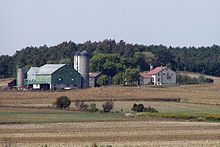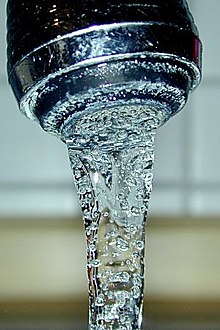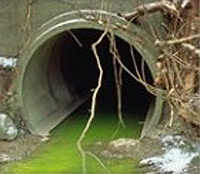Jump to: navigation, search
Water resources are sources of water that are useful or potentially useful to humans. Uses of water include agricultural, industrial, household, recreational and environmental activities. Virtually all of these human uses require fresh water.
97% of water on the Earth is salt water, leaving only 3% as fresh water of which slightly over two thirds is frozen in glaciers and polar ice caps.[1] The remaining unfrozen freshwater is mainly found as groundwater, with only a small fraction present above ground or in the air.[2]
Fresh water is a renewable resource, yet the world's supply of clean, fresh water is steadily decreasing. Water demand already exceeds supply in many parts of the world and as the world population continues to rise, so too does the water demand. Awareness of the global importance of preserving water for ecosystem services has only recently emerged as, during the 20th century, more than half the world’s wetlands have been lost along with their valuable environmental services. Biodiversity-rich freshwater ecosystems are currently declining faster than marine or land ecosystems.[3] The framework for allocating water resources to water users (where such a framework exists) is known as water rights.

A graphical distribution of the locations of water on Earth.
| Contents [hide] - 1 Sources of fresh water
- 1.1 Surface water
- 1.2 Under river flow
- 1.3 Ground water
- 1.4 Desalination
- 1.5 Frozen water
- 2 Uses of fresh water
- 2.1 Agricultural
- 2.2 Industrial
- 2.3 Household
- 2.4 Recreation
- 2.5 Environmental
- 3 Water stress
- 3.1 Population growth
- 3.2 Expansion of business activity
- 3.3 Rapid urbanization
- 3.4 Climate change
- 3.5 Depletion of aquifers
- 3.6 Pollution and water protection
- 3.7 Water and conflict
- 4 World water supply and distribution
- 5 Economic considerations
- 6 See also
- 7 Further reading
- 8 Notes
- 9 References
- 10 External links
|
[edit] Sources of fresh water
[edit] Surface water

Lake Chungará and Parinacota volcano in northern Chile
Surface water is water in a river, lake or fresh water wetland. Surface water is naturally replenished by precipitation and naturally lost through discharge to the oceans, evaporation, and sub-surface seepage.
Although the only natural input to any surface water system is precipitation within its watershed, the total quantity of water in that system at any given time is also dependent on many other factors. These factors include storage capacity in lakes, wetlands and artificial reservoirs, the permeability of the soil beneath these storage bodies, the runoff characteristics of the land in the watershed, the timing of the precipitation and local evaporation rates. All of these factors also affect the proportions of water lost.
Human activities can have a large and sometimes devastating impact on these factors. Humans often increase storage capacity by constructing reservoirs and decrease it by draining wetlands. Humans often increase runoff quantities and velocities by paving areas and channelizing stream flow.
The total quantity of water available at any given time is an important consideration. Some human water users have an intermittent need for water. For example, many farms require large quantities of water in the spring, and no water at all in the winter. To supply such a farm with water, a surface water system may require a large storage capacity to collect water throughout the year and release it in a short period of time. Other users have a continuous need for water, such as a power plant that requires water for cooling. To supply such a power plant with water, a surface water system only needs enough storage capacity to fill in when average stream flow is below the power plant's need.
Nevertheless, over the long term the average rate of precipitation within a watershed is the upper bound for average consumption of natural surface water from that watershed.
Natural surface water can be augmented by importing surface water from another watershed through a canal or pipeline. It can also be artificially augmented from any of the other sources listed here, however in practice the quantities are negligible. Humans can also cause surface water to be "lost" (i.e. become unusable) through pollution.
Brazil is the country estimated to have the largest supply of fresh water in the world, followed by Russia and Canada.[4]
[edit] Under river flow
Throughout the course of the river, the total volume of water transported downstream will often be a combination of the visible free water flow together with a substantial contribution flowing through sub-surface rocks and gravels that underlie the river and its floodplain called the hyporheic zone. For many rivers in large valleys, this unseen component of flow may greatly exceed the visible flow. The hyporheic zone often forms a dynamic interface between surface water and true ground-water receiving water from the ground water when aquifers are fully charged and contributing water to ground-water when ground waters are depleted. This is especially significant in karst areas where pot-holes and underground rivers are common.
[edit] Ground water

Sub-Surface water travel time

Shipot, a common water source in Ukrainian villages
Sub-surface water, or groundwater, is fresh water located in the pore space of soil and rocks. It is also water that is flowing within aquifers below the water table. Sometimes it is useful to make a distinction between sub-surface water that is closely associated with surface water and deep sub-surface water in an aquifer (sometimes called "fossil water").
Sub-surface water can be thought of in the same terms as surface water: inputs, outputs and storage. The critical difference is that due to its slow rate of turnover, sub-surface water storage is generally much larger compared to inputs than it is for surface water. This difference makes it easy for humans to use sub-surface water unsustainably for a long time without severe consequences. Nevertheless, over the long term the average rate of seepage above a sub-surface water source is the upper bound for average consumption of water from that source.
The natural input to sub-surface water is seepage from surface water. The natural outputs from sub-surface water are springs and seepage to the oceans.
If the surface water source is also subject to substantial evaporation, a sub-surface water source may become saline. This situation can occur naturally under endorheic bodies of water, or artificially under irrigated farmland. In coastal areas, human use of a sub-surface water source may cause the direction of seepage to ocean to reverse which can also cause soil salinization. Humans can also cause sub-surface water to be "lost" (i.e. become unusable) through pollution. Humans can increase the input to a sub-surface water source by building reservoirs or detention ponds.
[edit] Desalination
Desalination is an artificial process by which saline water (generally sea water) is converted to fresh water. The most common desalination processes are distillation and reverse osmosis. Desalination is currently expensive compared to most alternative sources of water, and only a very small fraction of total human use is satisfied by desalination. It is only economically practical for high-valued uses (such as household and industrial uses) in arid areas. The most extensive use is in the Persian Gulf.
[edit] Frozen water

An iceberg as seen from Newfoundland
Several schemes have been proposed to make use of icebergs as a water source, however to date this has only been done for novelty purposes. Glacier runoff is considered to be surface water.
The Himalayas, which are often called "The Roof of the World", contain some of the most extensive and rough high altitude areas on Earth as well as the greatest area of glaciers and permafrost outside of the poles. Ten of Asia’s largest rivers flow from there, and more than a billion people’s livelihoods depend on them. To complicate matters, temperatures are rising more rapidly here than the global average. In Nepal the temperature has risen with 0.6 degree over the last decade, whereas the global warming has been around 0.7 over the last hundred years.[5]
[edit] Uses of fresh water
Uses of fresh water can be categorized as consumptive and non-consumptive (sometimes called "renewable"). A use of water is consumptive if that water is not immediately available for another use. Losses to sub-surface seepage and evaporation are considered consumptive, as is water incorporated into a product (such as farm produce). Water that can be treated and returned as surface water, such as sewage, is generally considered non-consumptive if that water can be put to additional use.
[edit] Agricultural
It is estimated that 69% of worldwide water use is for irrigation, with 15-35% of irrigation withdrawals being unsustainable.[6]
In some areas of the world irrigation is necessary to grow any crop at all, in other areas it permits more profitable crops to be grown or enhances crop yield. Various irrigation methods involve different trade-offs between crop yield, water consumption and capital cost of equipment and structures. Irrigation methods such as furrow and overhead sprinkler irrigation are usually less expensive but are also typically less efficient, because much of the water evaporates, runs off or drains below the root zone. Other irrigation methods considered to be more efficient include drip or trickle irrigation, surge irrigation, and some types of sprinkler systems where the sprinklers are operated near ground level. These types of systems, while more expensive, usually offer greater potential to minimize runoff, drainage and evaporation. Any system that is improperly managed can be wasteful, all methods have the potential for high efficiencies under suitable conditions, appropriate irrigation timing and management. One issue that is often insufficiently considered is salinization of sub-surface water.
Aquaculture is a small but growing agricultural use of water. Freshwater commercial fisheries may also be considered as agricultural uses of water, but have generally been assigned a lower priority than irrigation (see Aral Sea and Pyramid Lake).
As global populations grow, and as demand for food increases in a world with a fixed water supply, there are efforts underway to learn how to produce more food with less water, through improvements in irrigation[7] methods[8] and technologies, agricultural water management, crop types, and water monitoring.
[edit] Industrial
It is estimated that 15% of worldwide water use is industrial. Major industrial users include power plants, which use water for cooling or as a power source (i.e. hydroelectric plants), ore and oil refineries, which use water in chemical processes, and manufacturing plants, which use water as a solvent.
The portion of industrial water usage that is consumptive varies widely, but as a whole is lower than agricultural use.
Water is used in power generation. Hydroelectricity is electricity obtained from hydropower. Hydroelectric power comes from water driving a water turbine connected to a generator. Hydroelectricity is a low-cost, non-polluting, renewable energy source. The energy is supplied by the sun. Heat from the sun evaporates water, which condenses as rain in higher altitudes, from where it flows down.
Three Gorges Dam is the largest hydro-electric power station Pressurized water is used in water blasting and water jet cutters. Also, very high pressure water guns are used for precise cutting. It works very well, is relatively safe, and is not harmful to the environment. It is also used in the cooling of machinery to prevent over-heating, or prevent saw blades from over-heating.
Water is also used in many industrial processes and machines, such as the steam turbine and heat exchanger, in addition to its use as a chemical solvent. Discharge of untreated water from industrial uses is pollution. Pollution includes discharged solutes (chemical pollution) and discharged coolant water (thermal pollution). Industry requires pure water for many applications and utilizes a variety of purification techniques both in water supply and discharge.
[edit] Household
It is estimated that 15% of worldwide water use is for household purposes. These include drinking water, bathing, cooking, sanitation, and gardening. Basic household water requirements have been estimated by Peter Gleick at around 50 liters per person per day, excluding water for gardens. Drinking water is water that is of sufficiently high quality so that it can be consumed or used without risk of immediate or long term harm. Such water is commonly called potable water. In most developed countries, the water supplied to households, commerce and industry is all of drinking water standard even though only a very small proportion is actually consumed or used in food preparation.
[edit] Recreation
Recreational water use is usually a very small but growing percentage of total water use. Recreational water use is mostly tied to reservoirs. If a reservoir is kept fuller than it would otherwise be for recreation, then the water retained could be categorized as recreational usage. Release of water from a few reservoirs is also timed to enhance whitewater boating, which also could be considered a recreational usage. Other examples are anglers, water skiers, nature enthusiasts and swimmers.
Recreational usage is usually non-consumptive. Golf courses are often targeted as using excessive amounts of water, especially in drier regions. It is, however, unclear whether recreational irrigation (which would include private gardens) has a noticeable effect on water resources. This is largely due to the unavailability of reliable data. Some governments, including the Californian Government, have labelled golf course usage as agricultural in order to deflect environmentalists' charges of wasting water. However, using the above figures as a basis, the actual statistical effect of this reassignment is close to zero.
Additionally, recreational usage may reduce the availability of water for other users at specific times and places. For example, water retained in a reservoir to allow boating in the late summer is not available to farmers during the spring planting season. Water released for whitewater rafting may not be available for hydroelectric generation during the time of peak electrical demand.
[edit] Environmental
Explicit environmental water use is also a very small but growing percentage of total water use. Environmental water usage includes artificial wetlands, artificial lakes intended to create wildlife habitat, fish ladders around dams, and water releases from reservoirs timed to help fish spawn.
Like recreational usage, environmental usage is non-consumptive but may reduce the availability of water for other users at specific times and places. For example, water release from a reservoir to help fish spawn may not be available to farms upstream.
[edit] Water stress

Best estimate of the share of people in developing countries with access to drinking water 1970–2000.
Main articles: water crisis and water stress
The concept of water stress is relatively simple: According to the World Business Council for Sustainable Development, it applies to situations where there is not enough water for all uses, whether agricultural, industrial or domestic. Defining thresholds for stress in terms of available water per capita is more complex, however, entailing assumptions about water use and its efficiency. Nevertheless, it has been proposed that when annual per capita renewable freshwater availability is less than 1,700 cubic meters, countries begin to experience periodic or regular water stress. Below 1,000 cubic meters, water scarcity begins to hamper economic development and human health and well-being.
[edit] Population growth
In 2000, the world population was 6.2 billion. The UN estimates that by 2050 there will be an additional 3.5 billion people with most of the growth in developing countries that already suffer water stress.[9] Thus, water demand will increase unless there are corresponding increases in water conservation and recycling of this vital resource.[10]
[edit] Expansion of business activity
Business activity ranging from industrialization to services such as tourism and entertainment continues to expand rapidly. This expansion requires increased water services including both supply and sanitation, which can lead to more pressure on water resources and natural ecosystems.
[edit] Rapid urbanization
The trend towards urbanization is accelerating. Small private wells and septic tanks that work well in low-density communities are not feasible within high-density urban areas. Urbanization requires significant investment in water infrastructure in order to deliver water to individuals and to process the concentrations of wastewater – both from individuals and from business. These polluted and contaminated waters must be treated or they pose unacceptable public health risks.
In 60% of European cities with more than 100,000 people, groundwater is being used at a faster rate than it can be replenished.[11] Even if some water remains available, it costs more and more to capture it.
[edit] Climate change
Climate change could have significant impacts on water resources around the world because of the close connections between the climate and hydrologic cycle. Rising temperatures will increase evaporation and lead to increases in precipitation, though there will be regional variations in rainfall. Overall, the global supply of freshwater will increase. Both droughts and floods may become more frequent in different regions at different times, and dramatic changes in snowfall and snowmelt are expected in mountainous areas. Higher temperatures will also affect water quality in ways that are not well understood. Possible impacts include increased eutrophication. Climate change could also mean an increase in demand for farm irrigation, garden sprinklers, and perhaps even swimming pools.
[edit] Depletion of aquifers
Due to the expanding human population, competition for water is growing such that many of the worlds major aquifers are becoming depleted. This is due both for direct human consumption as well as agricultural irrigation by groundwater. Millions of pumps of all sizes are currently extracting groundwater throughout the world. Irrigation in dry areas such as northern China and India is supplied by groundwater, and is being extracted at an unsustainable rate. Cities that have experienced aquifer drops between 10 to 50 meters include Mexico City, Bangkok, Manila, Beijing, Madras and Shanghai.[12]
[edit] Pollution and water protection
Main article: Water pollution
Water pollution is one of the main concerns of the world today. The governments of many countries have striven to find solutions to reduce this problem. Many pollutants threaten water supplies, but the most widespread, especially in underdeveloped countries, is the discharge of raw sewage into natural waters; this method of sewage disposal is the most common method in underdeveloped countries, but also is prevalent in quasi-developed countries such as China, India and Iran. Sewage, sludge, garbage, and even toxic pollutants are all dumped into the water. Even if sewage is treated, problems still arise. Treated sewage forms sludge, which may be placed in landfills, spread out on land, incinerated or dumped at sea.[13] In addition to sewage, nonpoint source pollution such as agricultural runoff is a significant source of pollution in some parts of the world, along with urban stormwater runoff and chemical wastes dumped by industries and governments.
[edit] Water and conflict
The only known example of an actual inter-state conflict over water took place between 2500 and 2350 BC between the Sumerian states of Lagash and Umma.[14] Yet, despite the lack of evidence of international wars being fought over water alone, water has been the source of various conflicts throughout history. When water scarcity causes political tensions to arise, this is referred to as water stress. Water stress has led most often to conflicts at local and regional levels.[15] Using a purely quantitative methodology, Thomas Homer-Dixon successfully correlated water scarcity and scarcity of available arable lands to an increased chance of violent conflict.[16]
Water stress can also exacerbate conflicts and political tensions which are not directly caused by water. Gradual reductions over time in the quality and/or quantity of fresh water can add to the instability of a region by depleting the health of a population, obstructing economic development, and exacerbating larger conflicts.[17]
Conflicts and tensions over water are most likely to arise within national borders, in the downstream areas of distressed river basins. Areas such as the lower regions of China's Yellow River or the Chao Phraya River in Thailand, for example, have already been experiencing water stress for several years. Additionally, certain arid countries which rely heavily on water for irrigation, such as China, India, Iran, and Pakistan, are particularly at risk of water-related conflicts.[17] Political tensions, civil protest, and violence may also occur in reaction to water privatization. The Bolivian Water Wars of 2000 are a case in point.
[edit] World water supply and distribution
Food and water are two basic human needs. However, global coverage figures from 2002 indicate that, of every 10 people:
- roughly 5 have a connection to a piped water supply at home (in their dwelling, plot or yard);
- 3 make use of some other sort of improved water supply, such as a protected well or public standpipe;
- 2 are unserved;
- In addition, 4 out of every 10 people live without improved sanitation.[6]
At Earth Summit 2002 governments approved a Plan of Action to:
- Halve by 2015 the proportion of people unable to reach or afford safe drinking water. The Global Water Supply and Sanitation Assessment 2000 Report (GWSSAR) defines "Reasonable access" to water as at least 20 liters per person per day from a source within one kilometer of the user’s home.
- Halve the proportion of people without access to basic sanitation. The GWSSR defines "Basic sanitation" as private or shared but not public disposal systems that separate waste from human contact.
As the picture shows, in 2025, water shortages will be more prevalent among poorer countries where resources are limited and population growth is rapid, such as the Middle East, Africa, and parts of Asia. By 2025, large urban and peri-urban areas will require new infrastructure to provide safe water and adequate sanitation. This suggests growing conflicts with agricultural water users, who currently consume the majority of the water used by humans.
Generally speaking the more developed countries of North America, Europe and Russia will not see a serious threat to water supply by the year 2025, not only because of their relative wealth, but more importantly their populations will be better aligned with available water resources. North Africa, the Middle East, South Africa and northern China will face very severe water shortages due to physical scarcity and a condition of overpopulation relative to their carrying capacity with respect to water supply. Most of South America, Sub-Saharan Africa, Southern China and India will face water supply shortages by 2025; for these latter regions the causes of scarcity will be economic constraints to developing safe drinking water, as well as excessive population growth.
1.6 billion people have gained access to a safe water source since 1990. [2] The proportion of people in developing countries with access to safe water is calculated to have improved from 30 percent in 1970[18] to 71 percent in 1990, 79 percent in 2000 and 84 percent in 2004. This trend is projected to continue.[19]
[edit] Economic considerations
Water supply and sanitation require a huge amount of capital investment in infrastructure such as pipe networks, pumping stations and water treatment works. It is estimated that Organisation for Economic Co-operation and Development (OECD) nations need to invest at least USD 200 billion per year to replace aging water infrastructure to guarantee supply, reduce leakage rates and protect water quality.[20]
International attention has focused upon the needs of the developing countries. To meet the Millennium Development Goals targets of halving the proportion of the population lacking access to safe drinking water and basic sanitation by 2015, current annual investment on the order of USD 10 to USD 15 billion would need to be roughly doubled. This does not include investments required for the maintenance of existing infrastructure.[21]
Once infrastructure is in place, operating water supply and sanitation systems entails significant ongoing costs to cover personnel, energy, chemicals, maintenance and other expenses. The sources of money to meet these capital and operational costs are essentially either user fees, public funds or some combination of the two.
But this is where the economics of water management start to become extremely complex as they intersect with social and broader economic policy. Such policy questions are beyond the scope of this article, which has concentrated on basic information about water availability and water use. They are, nevertheless, highly relevant to understanding how critical water issues will affect business and industry in terms of both risks and opportunities.

























